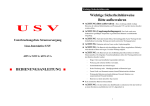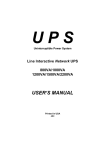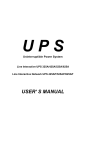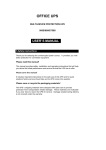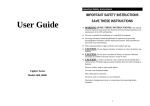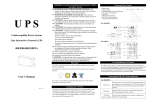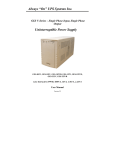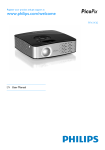Download Philips SPB4230WA Theatre director 12 outlets Uninterruptible power supply
Transcript
Uninterruptible Power System (UPS) SPB4230WA Register your product and get support at www.philips.com/welcome EN User Guide 3 Table of contents 1 2 2.1 2.2 2.2 Important Your UPS What’s in the box What you’ll also need UPS overview 4 4 5 5 6 3 3.1 3.2 Getting started Connect your UPS Connect your UPS to a phone/fax/modem Connect your UPS to a TV/VCR/DVDR/cable box Check the power requirement of your equipment 7 7 8 Using your UPS Using more of your UPS Storage Warranty and service Technical data Frequently asked questions 9 11 12 13 16 17 3.3 3.4 4 5. 6. 7. 8. 9. 8 9 3 1 Important Take time to read this manual before you use your UPS. It contains important information and notes regarding operating and maintaining your UPS and batteries. © 2007 Koninklijke Philips Electronics N.V. All rights reserved. Reproduction in whole or in part is prohibited without the written consent of the copyright owner. Trademarks are the property of Koninklijke Philips Electronics N.V. or their respective owners. Warnings •This product is intended for use in a controlled environment. • Keep away from sunlight to prevent heat build-up. • Do not disassemble or repair. • Product contains sealed lead-acid battery. Battery must be recycled. Cautions •Risk of electrical shock. Not for use outdoors or in other wet or damp areas, with aquariums, in hazardous environments requiring failsafe performance (such as nuclear facilities or aircraft), or for medical or life support equipment. This device must be properly connected to a grounded three prong receptacle, and must not be “daisy-chained” together in serial fashion with other power strips, uninterruptible power supplies, grounding adapters, other surge products or extension cords. •Do not dispose of batteries in a fire. The battery may explode. •A battery can present a risk of of electrical shock and a high short circuit current. Observe the following precautions when working on batteries : •Remove watches, rings or other metal objects •Use tools with insulated handles •Wear rubber gloves and boots •Do not lay tools or metal parts on tops of batteries •Disconnect the charging source prior to connecting or disconnecting battery terminals •Do not open or mutilate the battery. Exposed or damaged batteries can release electrolytes which are harmful to the skin and eyes and may be toxic. 4 Service of batteries should be performed or supervised by personnel knowledgeable of batteries and the required precautions. Keep unauthorized individuals away from batteries. When replacing batteries, replace with the same type as the original. Please save or recycle the packaging materials The UPS’s packaging materials are designed to protect the UPS during transport. These materials can be used to repack the UPS if it needs to be serviced. Damage during transit is not covered under the warranty. If you choose to discard the packaging materials, take them to your local recycling center. 2 Your UPS Congratulations on your purchase and welcome to Philips ! To fully benefit from the support that Philips offers, register your UPS at www.philips.com/welcome. This UPS (Uninterrupted Power System) has been designed to supply power to connected equipment in the event of an electrical blackout. It is also equipped with built-in surge protection to guard connected equipment against electrical damage. When your wall outlet is supplying normal AC power flow, the UPS provides surge protection and draws energy to charge its internal battery. When the AC power flow becomes abnormal, as in the instance of a blackout, the UPS will supply power to the connected equipment immediately, via its internal battery. Philips offers an entire line of UPS products to safeguard your home electronics and computer system. Product highlights Your UPS is equipped with the following features and functions. Intelligent microprocessor control Your UPS is a microprocessor-controlled unit. This means that it operates with the newest technology for high performance and powerful functionality. It is an “intelligent” protector that provides pure, reliable AC power to critical loads — guarding against electrical power blackouts, current fluctuations, surges and interference. The UPS will also save power, automatically turning off under back-up mode when none of the connected equipment is operating. Utilizing microprocessor control maximizes your UPS’s system flexibility and ensures reliability. Advanced battery management Visual and audible signals alert you about UPS and battery status. The self-test function allows the UPS to detect a weak battery before it is put into service.Your UPS will perform a self-test upon start-up. Automatic voltage regulation Allows the UPS to adapt to a wide power range and maintain a steady output of pure and reliable power to sensitive, connected equipment. Automatic frequency sensing Allows the UPS to automatically match frequency with the incoming utility power. High level battery charger Fully charges the internal battery and acts to prolong its life. Extended back-up time Prolongs the time your equipment has electricity during power blackouts. Solid State phone/fax/modem protection Provides maximum protection against surges present on standard two-wire “dial-up” phone service. Splitter phone line protection Splits incoming phone line into two outputs, supporting and protecting phone and modem. Coaxial cable protection Provides maximum protection against surges present on standard coax/broadband lines. Rotating LCD message panel display Displays time, AVR operation indicator, battery charge level (in AC mode), battery run time (in back-up mode), input voltage and battery load level. May be positioned horizontally or vertically. 2.1 What’s in the box • UPS • 6 ft RG6 coaxial cable • 6 ft phone cord • 6 ft RJ45 cable • 8 ft power cord with offset, right angle plug • (2) Adjustable rack mount brackets • Owner’s manual • Advanced power monitoring software with auto shutdown 2.2 What you’ll also need • A 3-wire grounded AC outlet to supply power to the UPS • A pointed tipped implement, such as a pen • All equipment being connected to the UPS Overload protection Guards against connecting components whose power requirements exceed that of the UPS. Functions in both in-line and battery modes. 5 1 2.3 UPS overview 1 2 3 4 5 6 7 Front panel 1 Power switch: Turns power to the UPS on or off. May be used as the master ON/OFF switch for all equipment connected to the battery back-up outlets by leaving the power buttons for the connected equipment ON. Also indicates the status of the UPS: • a steady light indicates the UPS is inline mode and using AC current • a flashing light indicates the UPS is in battery back-up mode 2 Time set control (minutes): Use this button to set the time in minutes. 3 Liquid crystal display (LCD) message panel: Displays UPS status information and time. 4 Surge protection LED indicator: A steady light signals surge protection is normal. 5 Ground LED indicator: A steady light signals grounding is normal. 6 EMI/RFI LED indicator: A steady light signals noise filtration is functioning properly. 7 Time set control (hours): Use this button to set the time in hours. 2 5 3 6 4 LCD message panel display 1 Digital clock: Displays present time. 2 AVR (Automatic Voltage Regulation) 3 4 5 6 indicator: Illuminated “AVR Activate” signals the AVR is actively functioning. Battery charge level: Signals the battery charging level in AC mode. Battery run time: Signals battery status in back-up mode. Input voltage: Measures the input voltage. Battery load level: Signals the total output load of the UPS. 1 2 3 4 5 6 7 8 9 Back panel 1 Network line protection 2 Telephone line protection with splitter (1 in/2 out) 3 USB port for software/computer interface 4 Surge protected outlets, stage 1 (up to 40dB) 5 Surge protection outlets, stage 2 (up to 58dB) 6 UPS battery back-up outlets, stage 3 (up to 65dB) 7 Circuit breaker 8 Power cord input 9 Four sets of coaxial line protectionwith gold connectors 6 3 Getting Started This section helps you with the first time installation of your UPS. 3.1 Connect your UPS Warning Carefully read the safety precautions in Section 1. Important, before you connect your UPS. Warning Before connecting your UPS to a power outlet, make sure the electrical power voltage matches with the UPS. For example, if the UPS voltage is 120V, the incoming electrical power should be 120V as well. Caution Do not use any extension cords, adapters, other grounding wires or electrical connections with your UPS. Doing so will void all Philips warranties. To connect your UPS: 1 Release the power cord from its twist tie. 2 Plug the end into a 3-wire grounded AC outlet. Note Make certain that the 3-wire grounded AC outlet that you are plugging the UPS into does not also service any appliances requiring heavy electricity, such as a refrigerator, air conditioner, copier, etc. Note It is possible that your UPS battery may have become depleted during shipping or storage. To ensure the best performance from your UPS, allow the battery to recharge at least six hours before first using your UPS. To charge the battery, simply plug the UPS into a properly grounded AC outlet and turn on. Turn off before connecting components 3 Plug your primary equipment’s (e.g. computer, monitor, any critical data storage device) power cords directly into the battery back-up outlets of your UPS. 4 Plug your peripherals (e.g. printer, fax, video and audio devices) into the surge protected outlets of the UPS. Note Do not plug a laser printer or plotter into your UPS. Its power demands are much higher than typical peripherals and may overload the UPS, causing the circuit breaker to trip. 3.2 Connect your UPS to a phone/ fax/modem Your UPS offers Solid State phone/fax/ modem protection. This requires you to connect your phone/fax/modem to the protected jacks on your UPS instead of connecting directly to the wall jack. This telephone line protection is designed to provide maximum protection from surges present on two-line or “dial-up” telephone service. Other communications networks which happen to use modular jacks may not benefit from this protection. 7 Caution The telephone line protection of this UPS could be rendered inoperable if improperly connected. Caution If you fail to connect the phone/fax/modem protection, your connected equipment will not be covered by the Philips Connected Equipment Warranty. Most modem damage can be prevented if you take the time to connect the phone/fax/modem protection. Your UPS offers “splitter” phone line protection. This works by splitting a single incoming phone line into two outputs, allowing both a phone and a modem or fax machine to be connected. Although it does not allow both devices to be used at the same time, both devices are protected. To connect telephone line protection: 1 Connect your phone/fax/modem line from your wall jack to the “input” jack on your UPS. 2 Connect a phone cord into the first phone output jack on the rear of the UPS. 3 Connect the other end of the phone cord to the phone/fax/modem jack of the device you want to protect. 4 Connect a second phone cord into the second phone output jack on the rear of the UPS. 5 Connect the other end of the phone cord to the phone/fax/modem jack of the device you want to protect. 8 Note To claim damage under the Philips Connected Equipment Warranty as a result of telephone service line transients, your equipment must be properly connected to a Philips UPS which offers telephone line protection, and your telephone service equipment must include a properly installed and operating “primary protection” device at the service entrance. (Such devices are normally added during telephone line installation.) 3.2 Connect your UPS to a TV/VCR/ DVDR/cable box Your UPS offers coaxial cable protection. This requires you to connect your TV/ VCR/DVDR/cable box to the protected jacks on your UPS instead of connecting directly to the wall jack. This coaxial cable protection is designed to provide maximum protection from surges present on standard coax/broadband lines. Other communication networks, such as antennas and satellite dishes, which happen to use coaxial connections, may not benefit from this protection. Caution The coaxial cable protection of this product could be rendered inoperable if improperly connected. Caution If you fail to connect the coaxial cable protection, your connected equipment will not be covered by the Philips Connected Equipment Warranty. Most TV/VCR/DVDR/ cable box damage can be prevented if you take the time to connect the coaxial cable protection. To connect coaxial cable protection: 1 Connect the incoming cable/broadband line to the first gold-plated coaxial connector input on your UPS. 2 Connect a coaxial cable into the goldplated coaxial connector output on your UPS. 3 Connect the other end of the coaxial cable to the coaxial connector input of the device you want to protect. 4 Repeat this process to connect three additional video devices. Note If the power requirement of your equipment is listed other than VA, convert the requirement into VA by doing the following calculations: For 120V systems: Watt (W) x 2 = ___VA or Amps (A) x 120V = ___VA You must also confirm that the equipment plugged into the battery back-up outlets does not require total power exceeding 1000VA, 500Watts, the capacity of the UPS. If the power requirement of the connected equipment exceeds the capacity for the UPS, overload may occur, causing the circuit breaker to trip. When an overload occurs, the UPS will emit a continuous alarm to warn you of this situNote ation. The UPS will then automatically turn To claim damage under the Philips Connect- off to protect itself and the connected ed Equipment Warranty as a result of coaxial equipment.You must then remove a device line transients, your equipment must be to correct the problem before returning properly connected to a Philips UPS which power to the UPS. offers coaxial line protection. 3.3 Check the power requirement of your equipment 4 Using your UPS Before turning on your UPS, you must first confirm that that the total power of your equipment does not exceed 1440VA, the total rating capacity of the unit. To determine the total power of your equipment: 1 Check the rear panel of each device for a power rating. This number is followed by either W or VA and usually located near the power cord. 2 Total the power requirements. Learn how to operate your UPS for everyday use. Caution UPS surge protection components are not designed to protect against sustained low voltage situations. Sustained low voltage situations can cause damage to some connected equipment. When you first turn the power on your 9 UPS, it will immediately begin a self test to determine if an overload situation exists. If it detects an overload, an audible alarm will sound.You will hear a long beep before the system automatically shuts down. If this occurs: 1 Unplug at least one piece of equipment from the battery back-up outlets. 2 Turn off the power to the UPS. Wait 5 seconds. 3 Make sure the circuit breaker is set. Turn the UPS back on. Note Your UPS is equipped with a self protection feature that prevents accidental damage if the UPS is turned on and off repeatedly. Once you turn your UPS off, you must wait 5 seconds before turning it on again. Philips recommends you perform a simulation test when using your UPS for the first time or when connecting an additional piece of equipment. To conduct a simulation test: 1 Turn on the UPS. 2 Wait for the power indicator to illuminate. 3 Unplug the UPS power cord from the wall. This simulates a power failure. When an electrical power failure occurs, the battery power outlets of your UPS will supply power to the connected equipment from its battery. An alarm will beep once every two seconds. 4. Confirm all equipment connected to the battery power outlets of your UPS is operating under the limited rating power. 10 5. Restore power to UPS by plug the power cord back into the wall outlet. Repeat this simulation test a few times to confirm your UPS is working properly and determine the expected runtime. Note If a power failure occurs immediately after you turn on the UPS, but before its initial self-test sequence, your UPS will automatically shut down. It will not restart until electrical power is restored. This allows your UPS to check the quality of the power that is delivered to your connected equipment. Tip To maintain a full battery charge, leave your UPS plugged in and turned on at all times. The surge protection of your UPS has a limited life. Even under normal circumstances, and in the absence of defects, this surge protection will end when the components providing protection exceed capacity and cease to provide protection from power surges and spikes. These surge protection components feature an internal protection that will disconnect them at the end of their useful life, but will still maintain power to your connected equipment (load). When this occurs, you will have to replace your UPS to restore protection to your connected equipment. Your UPS is equipped with an LED indicator display to keep you alert to its effectiveness. This surge protection indicator light is illuminated when the surge protection components are functioning properly. If this light is off, it indicates that the surge protection components have reached capacity and are no longer able to protect your connected equipment against surges. Your UPS also offers a “ground” indicator light to confirm that the wall outlet is wired properly. 5 Using more of your UPS Learn about more features of your UPS. Auto restart Your UPS is equipped with an auto shut down feature which activates when the battery level becomes too low to sustain power to your connected equipment and electricity is not present. For example, if you are away from home during a power outage, your UPS will immediately provide power to your connected equipment through its internal battery. If the power outage exceeds the runtime of the UPS, the UPS will automatically switch into Suspend Mode, ceasing power to your connected equipment. It will retain the little power it has remaining to ensure that, when the power does return, it is safe to channel to your equipment. Once the power returns, the UPS will automatically reset itself to normal operation and recharge its internal battery. Back-up alarm In the event of a power failure, your UPS will sound an alarm, alerting you that it is going into back-up mode. It will sustain this alarm, beeping slowly every two seconds. To mute the alarm: 1.Press the power button for one second and release. Warning Do not hold the power button down for more than 1 second when muting the alarm. Holding the power button down 3 seconds or longer will turn the UPS completely off, halting battery power to your connected equipment. Low battery alarm When your UPS has been in back-up mode for an extended time and its internal battery has been depleted down to 20% or 30% of its power, it will sound an alarm, beeping rapidly every half second.This alarm will continue until the UPS shuts down completely from battery exhaustion or it automatically returns to normal (LINE) operation. Rotating LCD display Your UPS may be positioned either horizontally or vertically. If you choose to use it in a vertical position, you will have to adjust the LCD panel from a horizontal to vertical position. 11 To adjust the LCD panel: 1 Insert a flat-headed screwdriver into the sides of the LCD panel. 2 Gently apply pressure to pop the LCD panel out of the UPS housing. To set the time: 1 Use the sharp end of a pen to firmly depress the hours button. 2 Hold the button down until the correct hour appears. 3 Release the button. The hour will be set. 4 Repeat this procedure to set the minutes, using the minutes button. 6 Storage Follow the steps below to store your UPS. To store your UPS: 1 Make sure the battery of the UPS is fully charged. 2 Turn off the power to the UPS. 1 Rotate the LCD panel 180°. 3 Unplug the UPS from the wall outlet. 4 Disconnect all equipment to the UPS. 5 Cover the UPS completely. During periods of extended storage, recharge the UPS battery every three months to ensure battery life. 2 Snap the LDC panel back into the UPS housing. 7 Warranty and Service Limited Lifetime Warranty Digital clock Your UPS features a digital clock as part of the LCD panel. 12 Philips warrants that this product shall be free from defects in material, workmanship, and assembly under normal use, in accordance with the specifications and warnings, for the life of this product. A surge protector protects your equipment by absorbing and dissipating dangerous excess voltage and preventing most of it from reaching your sensitive equipment. Because all surge protectors have a limited capacity to absorb, the life of this product will end when that capacity is reached. This warranty extends only to the original purchaser of the product, and is not transferable. To exercise your rights under the warranty, you must provide proof of purchase in the form of an original sales receipt that shows the product name and the date of purchase. For customer support, or to obtain warranty service, please call 919-573-7863. EXCEPT FOR THE CONNECTED EQUIPMENT WARRANTY, IF ANY, APPLICABLE TO THIS PRODUCT, THERE ARE NO OTHER EXPRESS OR IMPLIED WARRANTIES. Philips’ liability hereunder is limited to repair or, at its option, replacement of the product. Incidental, special and consequential damages are disclaimed where permitted by law. This warranty gives you specific legal rights.You may also have other rights that vary from state to state. Not intended for mounting on a desk surface or on a similar furnishing surface. CALIFORNIA PROPOSITION 65 WARNING (All Products) WARNING: This product contains chemicals known to the State of California to cause cancer, birth defects, and/or reproductive harm. CONNECTED EQUIPMENT WARRANTY If any equipment is damaged by impulses from lightning or other power transients, or by momentary (less than 1 ms) voltage surges or spikes (an “Occurrence”) while properly connected through this Philips surge protector to a properly wired AC power line with protective ground (and if applicable, properly wired telephone, data or coaxial cable line), subject to the conditions and limitations of this warranty, Philips will, at its option, either (a) pay for the repair the equipment, or (b) pay an amount equal to the current fair market value of damaged equipment or the original purchase price of the equipment, whichever is less, up to the maximum amount stated on the product package. The fair market value of the equipment shall be the current value of the equipment specified in the most recent edition of Orion Blue Book (by Orion Research Corporation, Roger Rohrs Publisher) or a valuation as determined by Philips in its reasonable discretion. The period covered by this warranty is the lifetime of the surge protector, which means until the surge protector has exceeded its capacity to protect against surges and spikes. The “Protection Working” indicator will no longer be lit when this capacity is exceeded. Additionally, the capacity of the surge protector will be exceeded after an Occurrence. Conditions and Limitations: This warranty is for the sole benefit of the original purchaser of the Philips surge 13 protector. In order to exercise its rights under this warranty, the claimant must produce the original dated proof of purchase or reasonably equivalent documentation. Under no circumstances shall this warranty benefit a third party, including an insurance company claiming through a right of subrogation or otherwise. If the applicable Philips product is an AC surge protector only that does not have telephone or coaxial cable protection, this warranty does not apply if the power disturbance damages your equipment through the telephone or coaxial cable lines. You are only covered if the disturbance entered through the AC line. In order to be covered for power transients that enter through the telephone or coaxial cable line, the connected equipment must be properly connected to a Philips product that includes telephone and/or coaxial cable line protection. If the applicable Philips product does have telephone or coaxial cable line protection, in order to claim damage as a result of telephone or coaxial cable service line transients, the equipment must be properly connected to the surge protector (see Handbook for installation instructions), and your telephone service equipment must include a properly installed and operating “primary protection” device at the service entrance. (Such devices are normally installed during line installation). Philips reserves the right to investigate the surge protector, the damaged connected equipment and the site where the damage occurred. If Philips determines that it is 14 unrealistic to ship the damaged equipment to its facility, Philips may designate a local equipment repair facility to inspect and estimate the cost to repair such equipment. Any and all costs of shipping the surge protector and the damaged equipment to and from Philips or to and from a Philips designated facility for inspection or repair is the responsibility of the claimant. Philips reserves the right to negotiate the cost of repairs. Damaged equipment must remain available for inspection until the claim is finalized. Whenever claims are settled, Philips reserves the right to be subrogated under any existing insurance policies the claimant may have. This connected equipment warranty is null and void if: the surge protector in use at the time of the Occurrence is not provided to Philips for inspection upon Philips’ request. the surge protector was improperly installed, altered in any way or tampered with. the surge protector was being used in a manner contrary to the owner’s manual or other instructions, labels or warnings accompanying the product. the damage to the connected equipment did not result from an Occurrence, or no Occurrence in fact took place. repair or replacement of the damaged connected equipment is covered under manufacturers’ warranty or any applicable extended warranties. the damaged connected equipment was not plugged directly into the surge protector. the surge protector was not connected directly into a properly grounded power source. you have already recovered (or are seeking recovery) of the value of any damaged connected equipment from the manufacturer or an insurance company. Exclusions This warranty does not cover damage due to: an act of God (other than lightning) such as flood, erosion or earthquake. an accident. improper use of the product, such as for an aquarium or other situation involving exposure to moisture. war, vandalism, theft, normal-use wear and tear, erosion, depletion, obsolescence or abuse. low voltage disturbances (i.e. brownouts, sags or power outages). non-authorized modification or alteration of the surge protector. Warranty Claim Procedure Claims under this warranty must be made within 15 days from the date of the Occurrence and must be accompanied by proof that the claimant is the original purchaser of the surge protector, including a receipt for the purchase of the surge product. This warranty is valid for Occurrences in the USA and Canada only. Call Philips’s Customer Support at (919) 573-7863 within 15 days of the Occurrence. Be prepared to provide the following information: The model number of the surge protector. The equipment (make and model number) that was connected to the surge protector. The equipment (make and model number) that was damaged as a result of the Occurrence, and the extent of the damage. The date of the Occurrence When and where you purchased your surge protector. Your original dated sales receipt. Your Philips Customer Support Representative will provide you with a Return Authorization Number (RA#) and shipping instructions. Return the product with your original dated sales receipt and a description of the problem, freight prepaid, to the address provided by the Philips customer support representative. Products returned to Philips or to a Philips designated service center must have an RA# included with the product to be accepted. To file a claim under this Connected Equipment Warranty, you must do the following: 15 8 Technical data Input Maximum capacity 1440VA Voltage 100-120V* +/-25% at line input Current 12A Frequency 50 or 60Hz* +/-10% (auto sensing) Output Capacity 1000VA Voltage (on battery) Simulated sine wave at 100V/115V +/-5% Frequency (on battery) 50 or 60Hz* +/-1Hz Auto Voltage Regulation AVR automatically increases output voltage (AVR function) 15% above input voltage if -9% to -25% of nominal. AVR decrease output voltage 13% below input voltage If +/-9% to +25% of nominal Transfer time 2/4 milliseconds, including detection time Protection and filtering 16 Spike protection 5100 joules, 2ms Overload protection UPS automatically shuts down if overload exceeds 120% of nominal at 30 seconds and 130% at 3 seconds Unit input Fuse or circuit breaker for overload and short circuit protection Short circuit UPS output cut off immediately or input fuse protection BatteryType Sealed, maintenance-free lead acid Recharge time 6 hours typically (to 90% of full capacity) Protection Automatic self test and discharge protection Quantity of batteries DC voltage 12V (DC) Dimension: Main unit Net weight 22.7lbs (10.3Kg) Dimensions WxDxH 16.93” x 12.7” x 3.74” (mm) (430 x 323 x 95) 1 Alarm type Battery back-up Slow, beeping sound (approximately 0.47Hz) Low battery Rapid beeping sound (approximately 1.824Hz) Overload Continuous beeping sound Other Operating environment 3,500 meters maximum elevation, 9 – 95% humidity, non-condensing, 0 – 40° C Noise level <40dBA (1 meter from surface) *UL-listed rating 9 Frequently asked questions Here you will find the most frequently asked questions and answers about your UPS. For further help, visit www.philips. com/support or call 919-573-78563 in North America. To keep the warranty valid, never try to repair the system yourself. If you encounter problems when you use your UPS, check the following points before you contact Philips. If the problem remains unsolved, go to the Philips website www. philips.com/support or contact Philips at 919-575-7863 in North America. When you contact Philips, make sure that your UPS is nearby and the model number and serial number are available. What should I do if I cannot turn the UPS on or the LED light will not illuminate? This may occur if the battery voltage is less than 10V. Recharge the UPS for a minimum of six hours. If the problem persists, it may be PCB (Printed Circuit Board) failure.You will have to call for service to replace the PCB. What should I do if my UPS is always operating in the battery back-up mode? First, make sure the power cord is securely engaged in the AC outlet. If the power cord is secure, it may be possible the AC fuse is burnt out. Check the fuse and replace, if necessary. If the AC fuse is operational and the problem persists, the line voltage may be too high, too low or blacked out. In this case, you must wait for a return to normal conditions. If none of these solutions return the UPS to normal operation, it may be PCB failure.You will have to call for service to replace the PCB. What should I do if the UPS back-up time is too short? This could occur if the UPS battery is not fully charged. Recharge the UPS battery for a minimum of six hours. If, after recharging the battery, the UPS back-up time is still too short, it may be due to 17 PCB failure.You will have to call for service to replace the PCB. What should I do if the alarm sounds continuously? The alarm is alerting you that an overload situation is occurring. Immediately disconnect a device from the UPS. If the alarm continues, disconnect another device, and so on until the alarm stops. Check the total power requirements of your connected equipment and make sure it does not exceed the capacity of the UPS (1000V) before reconnecting. 18 19 Specifications are subject to change without notice Trademarks are property of Philips Accessories and Computer Peripherals 2007© Philips Accessories and Computer Peripherals, Ledgewood, NJ USA www.philips.com 20




















